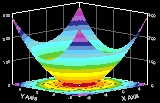 |
|
NEWS
|
|
NLREG has been selected as the "Editor"s Pick" by
SoftSeek.

|
|
|
NLREG is in use at hundreds of universities, laboratories, and government agencies around the world (over 20 countries). For a list of a few organizations using NLREG click here.
|
|
|
If you have categorical variables, you may want to use a Decision Tree to model your data. Check out the DTREG Decision Tree Builder.
|
|
|
You also should check out the News Rover program that automatically scans Usenet newsgroups, downloads messages of interest to you, decodes binary file attachments, reconstructs files split across multiple messages, and eliminates spam and duplicate files.
|
|
 |
|
 |
|
|
NIST Statistical Reference Datasets
The
Statistical Reference Datasets Project
was developed by staff of the
Statistical Engineering Division
and the
Mathematical and Computational Sciences Division within the
Information Technology Laboratory
of the
National Institute of Standards and Technology.
The NIST reference dataset suite contains 27 datasets for validating
nonlinear least squares regression analysis software. NLREG has been
used to analyze all of these datasets with the following results: NLREG
was able to successfully solve 24 of the datasets, producing results that
agree with the validated results within 5 or 6 significant digits. Three
of the datasets (Gauss1, Gauss2 and Gauss3) did not converge, and NLREG
stopped with the message "Singular convergence. Mutually dependent parameters?"
The primary suggested starting values were used for all datasets except
for MGH17, Lanczos2 and BoxBOD which did not converge with the primary
suggested starting values but did converge with the secondary suggested
starting values.
In all cases where NLREG reported that it obtained
a solution, the answers were correct.
Results produced by NLREG when running each reference dataset can be
viewed below. Note in the analysis listings that the background information
about the dataset provided by NIST is listed first as an extended
comment enclosed between
'/*' and '*/' delimiters, the actual NLREG program (usually only a few lines)
follows, and the output generated by NLREG is the final portion of the listing.
Background Information
|
Dataset Name | |
Level of
Difficulty | |
Model
Classification | |
Number of
Parameters | |
Number of
Observations | |
Source |
|
| Misra1a | |
Lower | |
Exponential | |
| 2 | | |
| 14 | | |
Observed |
| Chwirut2 | |
Lower | |
Exponential | |
| 3 | | |
| 54 | | |
Observed |
| Chwirut1 | |
Lower | |
Exponential | |
| 3 | | |
| 214 | | |
Observed |
| Lanczos3 | |
Lower | |
Exponential | |
| 6 | | |
| 24 | | |
Generated |
| Gauss1 | |
Lower | |
Exponential | |
| 8 | | |
| 250 | | |
Generated |
| Gauss2 | |
Lower | |
Exponential | |
| 8 | | |
| 250 | | |
Generated |
| DanielWood | |
Lower | |
Miscellaneous | |
| 2 | | |
| 6 | | |
Observed |
| Misra1b | |
Lower | |
Miscellaneous | |
| 2 | | |
| 14 | | |
Observed |
|
| Kirby2 | |
Average | |
Rational | |
| 5 | | |
| 151 | | |
Observed |
| Hahn1 | |
Average | |
Rational | |
| 7 | | |
| 236 | | |
Observed |
| Nelson | |
Average | |
Exponential | |
| 3 | | |
| 128 | | |
Observed |
| MGH17 | |
Average | |
Exponential | |
| 5 | | |
| 33 | | |
Generated |
| Lanczos1 | |
Average | |
Exponential | |
| 6 | | |
| 24 | | |
Generated |
| Lanczos2 | |
Average | |
Exponential | |
| 6 | | |
| 24 | | |
Generated |
| Gauss3 | |
Average | |
Exponential | |
| 8 | | |
| 250 | | |
Generated | |
| Misra1c | |
Average | |
Miscellaneous | |
| 2 | | |
| 14 | | |
Observed |
| Misra1d | |
Average | |
Miscellaneous | |
| 2 | | |
| 14 | | |
Observed |
| Roszman1 | |
Average | |
Miscellaneous | |
| 4 | | |
| 25 | | |
Observed |
| ENSO | |
Average | |
Miscellaneous | |
| 9 | | |
| 168 | | |
Observed |
|
| MGH09 | |
Higher | |
Rational | |
| 4 | | |
| 11 | | |
Generated |
| Thurber | |
Higher | |
Rational | |
| 7 | | |
| 37 | | |
Observed |
| BoxBOD | |
Higher | |
Exponential | |
| 2 | | |
| 6 | | |
Observed |
| Ratkowsky2 | |
Higher | |
Exponential | |
| 3 | | |
| 9 | | |
Observed |
| MGH10 | |
Higher | |
Exponential | |
| 3 | | |
| 16 | | |
Generated |
| Eckerle4 | |
Higher | |
Exponential | |
| 3 | | |
| 35 | | |
Observed |
| Ratkowsky3 | |
Higher | |
Exponential | |
| 4 | | |
| 15 | | |
Observed |
| Bennett5 | |
Higher | |
Miscellaneous | |
| 3 | | |
| 154 | | |
Observed |
Return to NLREG home page
Download demonstration copy of NLREG.
Download manuals for NLREG.
Purchase NLREG.
DTREG Decision Tree building software.
|